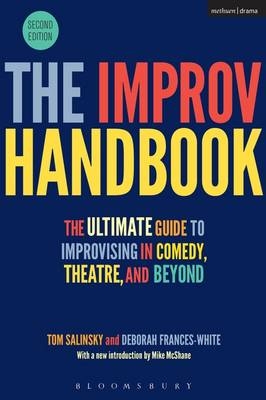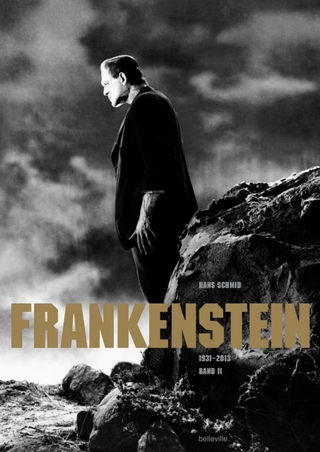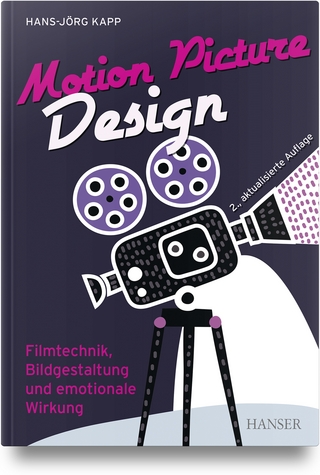
The Improv Handbook
Methuen Drama (Verlag)
978-1-350-02616-2 (ISBN)
First published in 2008, this second edition features a new foreword by comedian Mike McShane, as well as new exercises on endings, managing blind offers and master-servant games, plus new and expanded interviews with Keith Johnstone, Neil Mullarkey, Jeffrey Sweet and Paul Rogan.
The Improv Handbook is a one-stop guide to the exciting world of improvisation. Whether you’re a beginner, an expert, or would just love to try it if you weren’t too scared, The Improv Handbook will guide you every step of the way.
Tom Salinsky is the co-founder (with Deborah Frances-White) of The Spontaneity Shop. He and Deborah have performed improvisation for the Royal Court, the RSC Summer Season, the Gilded Balloon at the Edinburgh Festival, and at the Bloomsbury Theatre. They have toured the world and performed at many comedy festivals by invitation. They teach at RADA, The Actors Centre, The National Youth Theatre, and many other colleges and institutions, as well as their own successful workshop program. Deborah Frances-White is a stand-up comedian best known for her BBC Radio 4 show Deborah Frances-White Rolls the Dice. She’s performed comedy around the world including The Edinburgh Festival, The Melbourne International Comedy Festival and Roadshow and The London Storytelling Festival. Her book Off the Mic, co-authored with Marsha Shandur, was published by Bloomsbury Methuen Drama in 2015.
Contents
Foreword by Mike McShane
Introduction to the Second Edition
Introduction
Section One: What Is Improvisation?
1.1 What Was Improvisation?
Antiquity
Viola Spolin
Keith Johnstone
ImprovOlympic
The Spontaneity Shop
1.2 Improvisation in Performance
Keith Johnstone and Competitive Improvisation
Del Close and the Harold
Improvisation On TV
Intermission: “Two Stories”
#1 “From Innovation to Art Form”
#2 “Two Stories”
Section Two: How to Improvise
2.1 How to Use This Section
2.2 Teaching and Learning
2.3 Spontaneity
Pointing at Things
What are you doing?
2.4 Saying Yes
2.5 What Comes Next
The Importance of Platforms
Lengths of Platforms
Keeping Promises
Providing Feedback
The Right Trouble for The Right Hero
Solving Problems
Join The Dots
Committees
Endings
The Magic Formula?
2.6 Status
Introducing The Concepts
What is status?
Status Off-Stage
Still Heads
Status Ladders
High Status Competitions
Happy High Status
2.7 Go Through an Unusual Door
Everything for a Reason
Making Assumptions
Strategies for Breaking the Routine
Variations
The CJ Sweep
Tilting
2.8 Working Together
Word at a Time
Standing Wave
Master/Servant Dubbing
Over-Confessing
Other Games
2.9 Being Changed
Status Switch
Speaking in Tongues
2.10 More on Masters and Servants
The Chair Game
Fingersnaps
Master/Servant Double Header
2.11 Twitching, Topping and Paper-flicking
2.12 Playing Characters
What is a Character?
Changing the Body
Hilarious Geisha
Characters From a Hat
Shoe Shops
Opposite, Arbitrary, Extreme
Characters with Depth
Characters with Dimension
What do you Want?
2.13 You Can’t Learn Mime from a Book
Fixed Points
Popping
Making Noises
2.14 Control Freak
Hypnotist magician
Sandy Carroll
2.15 Finding the Game in the Scene
2.16 Continue or Thank You
2.17 Agree, agree, agree
When Harry Met Sally
Photo Albums
2.18 Playing Games
Three Word Sentences
Questions Only
Good Games
Dumb But Fun
Never Play
Freak Show Games
Difficult and Easy Games
2.19 Final Thoughts
PROBLEM: Wimps
PROBLEM: Joker
PROBLEM: Yes-sayer
PROBLEM: Shiner
PROBLEM: Random
PROBLEM: Hard worker
Gorilla Directing vs. Micetro Directing
How to be Directed
Final Words to Students at The End of a Workshop or Series of Workshops
Intermission: THE RULES AND WHY THERE AREN’T ANY...
Never Ask a Question
Know the Other Person
Never Argue, Always Agree
Avoid Transaction Scenes
Start in the Middle
Scripted vs. Improvised Comedy
How to Improvise a Scene That Incorporates All This Advice
Section Three: How to Improvise in Public
3.1 Feel the Fear and Do It Anyway
3.2 Starting a Company
3.3 Nuts and Bolts
What show?
What name?
Frequency of Shows
Rehearsal Space
Finding a Venue
Other People’s Shows
Fliers and Posters
Internet
Press
Selling Tickets
Starting the Show
Music and Lights
Ending Scenes
Getting Suggestions
Using Audience Members
Ending the Show
The Next Show
Festivals
Intermission: THE PARADOX OF IMPROVISATION
Section Four: Making Improvisation Pay
4.1 Performing?
4.2 Teaching Workshops
4.3 Corporate Entertainment
4.4 Corporate Training
4.5 Corporate Events
4.6 How to Get Corporate Work
Intermission: WOMEN IN IMPROV
Section Five: Talking to Improvisers
5.1 Keith Johnstone—The Innovator
5.2 Neil Mullarkey—The Comedy Store Player
5.3 Randy Dixon—The Synthesizer
5.4 Jonathan Pitts—The Impresario
5.5 Charna Halpern—The Keeper of the Harold
5.6 Mick Napier—Power Improviser
5.7 Dan O’Connor—West Coast Legend
5.8 Patti Stiles—Our Teacher
5.9 David Fenton—Theatresports MC Down Under
5.10 Tobias Menzies—The Actor
5.11 Jeffrey Sweet—Illegitimate Grandfather of American improv
5.12 Dylan Emery—Starter of Showstopper
5.13 Paul Rogan—An English Actor and Improviser in LA
5.14 Mike McShane—Transatlantic Improviser and Actor
5.15 Tom Salinsky discusses the improv show Voices in Your Head and its spin-offs with Deborah Frances-White
Afterword
Appendix One: GAMES
Good Games
Animal Expert
Death In A Minute
Dubbing
Fight For Your Number
Handbag
Hat Game
It’s Tuesday
Laugh And Leave
No S
The Removalists
Sexy Smelly Stupid
Small Voice
Speak In One Voice
Speed Dating
Twins
Typewriter
Dumb But Fun
Backwards Scene
Clap Switcheroo
Da Doo Ron Ron
ID Cards
Inner Monologue
Panel
Paper chase
Pillars
Sound Effects
Thumbs Up Thumbs Down
Never Play
Die
Entrances And Exits
Freeze Tag
Genre Rollercoaster Et Al.
Sign Language Translation
Superheroes
Warm-Up Games
Bibbity Bibbity Bop
Big Booty
Electric Company
Fling Shoo-ey
Greetings
I Am, I Am, I Am, I’ll Take
More Stories Like That
Sevens
Spotlight
Yes Let’s/Nope
You
Appendix Two: SYLLABUS
DAY ONE: Spontaneity
DAY TWO: Status
DAY THREE: Working Together
DAY FOUR: Telling Stories
DAY FIVE: Being Changed
DAY SIX: Defining
DAY SEVEN: Failure
DAY EIGHT: Characters
Glossary of Terms
Thanks
Bibliography
| Erscheinungsdatum | 20.10.2017 |
|---|---|
| Reihe/Serie | Performance Books |
| Verlagsort | London |
| Sprache | englisch |
| Maße | 156 x 234 mm |
| Gewicht | 788 g |
| Themenwelt | Kunst / Musik / Theater ► Film / TV |
| Kunst / Musik / Theater ► Theater / Ballett | |
| ISBN-10 | 1-350-02616-6 / 1350026166 |
| ISBN-13 | 978-1-350-02616-2 / 9781350026162 |
| Zustand | Neuware |
| Haben Sie eine Frage zum Produkt? |
aus dem Bereich


